What Are the Remote Patient Monitoring Devices in Healthcare You Should Care About?
Here’s what we’ll cover:
Pulse oximeters can help patients with asthma and other lung or heart problems
Wearables (such as smart watches) regularly monitor daily patient routines
Blood pressure cuffs help patients with high blood pressure monitor their condition
Adopting a remote patient monitoring system can help your healthcare organization prevent severe, costly health outcomes in patients (particularly those with chronic conditions), while also improving the overall health of patients with chronic care management or ongoing medical conditions.
What is remote patient monitoring: Remote patient monitoring is a healthcare delivery model that uses tech to monitor patients’ health outside of your clinic or practice. Essentially, remote patient monitoring uses electronically transmitted patient health data to assess patient vitals remotely. It’s also an important aspect of value-based care, a pricing model that incentivizes your practice based on the quality of services you provide to patients.
Remote patient monitoring programs come with a variety of benefits. From retaining and attracting patients to giving your patients more control over their health, a remote patient monitoring program is a crucial part of any telehealth or virtual care program.
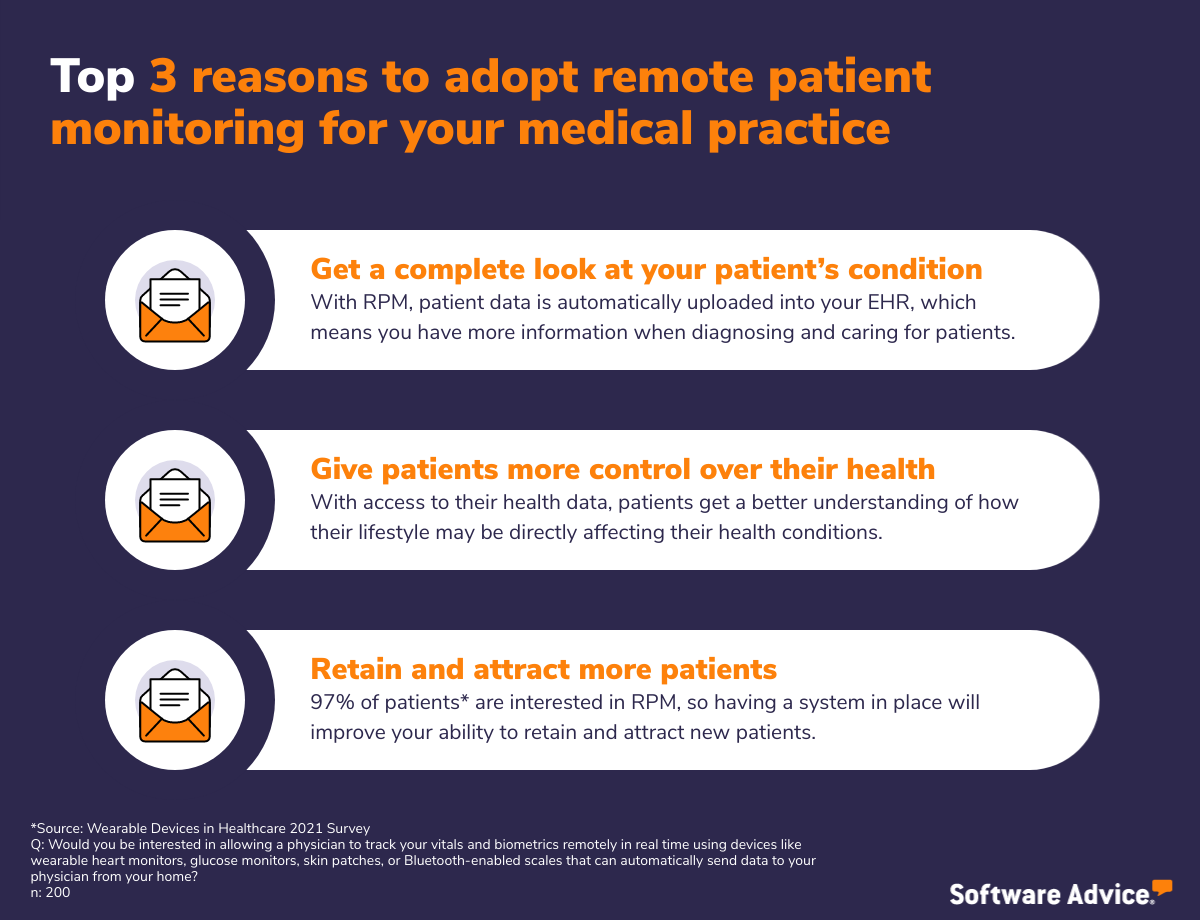
Looking for more information about remote patient monitoring? Check out What Is Remote Patient Monitoring, and Why Should You Adopt It for Your Practice?
In this article, we will focus on the different remote monitoring devices you can employ to reap all of the benefits that remote patient monitoring brings to your practice and patients.
What are remote patient monitoring devices?
First let’s take a step back and examine just what makes a remote patient monitoring device.
Plenty of at-home monitoring devices exist out there for patients, but what makes a remote patient monitoring device special is that it has connectivity to some sort of phone app. Now, instead of that data disappearing into the void, it gets directly uploaded into your patients’ records which gives you a more holistic view into their overall health.
Most remote patient monitoring services only store data which means you’ll have to navigate several different software systems to get a complete look at your patients’ health. But there are solutions that integrate directly with the software you’re already using, like electronic medical records (EMR).
When searching for remote patient monitoring devices, make sure you ask the vendor if their devices integrate with your current software or if you’ll have to use a different solution entirely.
Whether it’s step trackers, wearable heart monitors, blood pressure cuffs, glucose monitors, or pulse oximeters, these smart devices can help you observe, report, and analyze your patients’ acute or chronic conditions, such as diabetes, wherever they are.
Remote monitoring devices that patients have used to monitor their health at home have been around for a while (think blood sugar monitors), but the ability to digitally track and monitor them is a relatively new development. For the purposes of this article, assume all devices we discuss are smart devices which monitor and upload data to your systems.
Not only do they give you access to more data, but they take a lot of the stress out of healthcare for a huge range of patients by giving them more direct control over their health outcomes.
With constant access to concrete health data, patients get a better understanding of how their lifestyle may be directly affecting their health conditions. This visibility encourages them to adopt healthier lifestyle habits for healthier outcomes. And healthier outcomes mean lower risks of costly or potentially life-threatening conditions.
Cost of remote patient monitoring devices
One of the great things about remote patient monitoring is that the only tech required is a medical device that collects and interprets physiological data such as the heart rate, blood glucose level, blood pressure, respiration rate, body temperature, and blood volume. Not to mention, Medicare reimburses your practice for remote monitoring services, just like in-person services.
You also have the option of leasing these devices from remote patient monitoring service providers in certain cases. The upfront costs are reduced, but the ongoing cost is more significant over the months and years.
If you decide you want to distribute the devices yourself, the upfront cost is more significant, but you have control over which devices your patients use, leading to more consistency and less technical difficulties.
Additionally, you can provide your patient with a list of approved devices that integrate with your provider and system so that they can then make the decision for themselves based on cost and functionality. This means that you have more variables when it comes to the different devices being used, but be aware that this might mean more technical issues down the line.
Pulse oximeters can help patients with asthma and other lung or heart problems
A pulse oximeter clips to either a finger or earlobe to measure pulse as well as light wavelengths that determine blood oxygen levels. These chronic care management devices are nothing new and are often used by patients with asthma, lung issues, and chronic heart problems, which is why it’s a no-brainer to switch to a smart device instead of the more traditional type.
Traditionally, patients would need to take their reading and write it down manually. They would then bring the results with them to their next scheduled appointment, and you would have to upload the data manually into your machine to get an overall picture.
With a smart pulse oximeter, you have access to this data before your patient’s appointment which can help you make a more informed care plan. Additionally, you can come prepared with suggestions instead of using the appointment time to go over the data.
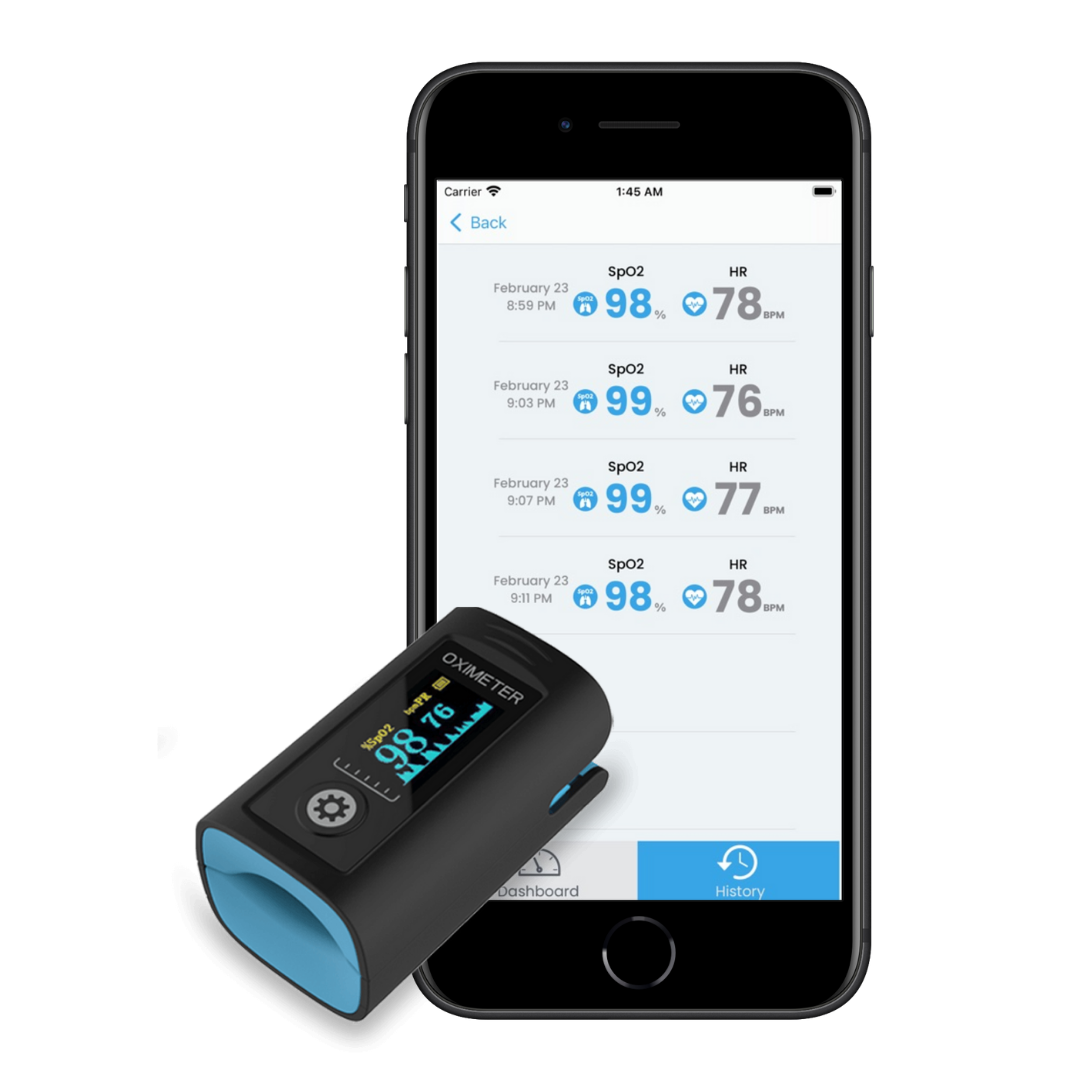
Healthmote’s remote pulse oximeter (Source)
These devices are also particularly helpful for conditions such as COVID-19 because they can detect declining lung function, which might indicate the need for a test.
Cardiologists should be particularly interested in using smart pulse oximeters, but general healthcare providers or care managers should also consider their use, depending on the number of patients with ongoing heart and lung conditions.
Continuous glucose monitors help patients with diabetes understand what factors affect their chronic condition
The traditional way patients with diabetes use glucose monitors to monitor their blood sugar is by pricking their finger to get a drop of blood for the glucose monitor to analyze. Similar to traditional pulse oximeters, patients would write these results down and bring them to their next checkup.
More recently, continuous glucose monitors have become commonplace that take away the need for your patients to stick their finger to draw blood. These devices use a small sensor that’s placed just beneath the skin which continuously monitors blood sugar levels throughout the day, uploading the snapshot to a smart device.
Patients who are accustomed to traditional methods of monitoring blood sugar levels will find your practice more appealing if you offer this less invasive solution. Plus, you gain the added benefit of having more insight into their ongoing health.
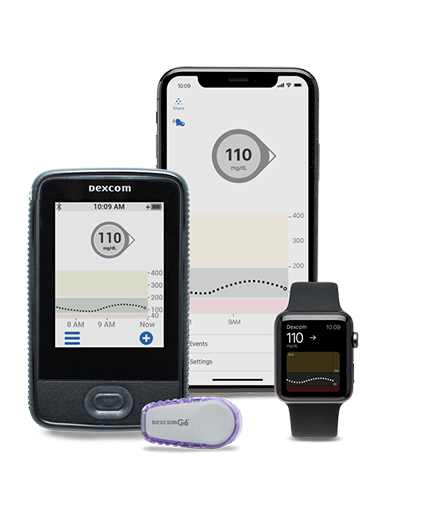
Dexcom’s glucose monitoring devices (Source)
Devices like this come with a wide range of benefits for you and your patients:
Help you monitor medication effects in real time
Track how diet and exercise affects blood sugar levels
Demonstrates how stress can affect blood sugar levels
Track progress toward goals
Signal when a patient might need to schedule a check-up
Care managers and general practitioners with a large number of patients with diabetes should consider upgrading and using glucose monitors.
Wearables (such as smart watches) regularly monitor daily patient routines
In 2021, the number of global Apple Watch users surpassed 100 million, and Fitbit currently has about 30 million active users.
Personal wearable devices like fitness trackers and smart watches are increasingly popular tools which help your patients track their activity. They can offer your healthcare organization a window into your patients’ day-to-day routine.
You can use this data to help form a patient’s treatment plan. And it’s an easy way for your patients to feel like they have some control over their fitness and health outcomes.
What’s more, according to our recent survey of 485 U.S. patients, 96% are interested in sharing the data collected by these wearable medical devices with their providers to help improve their health.
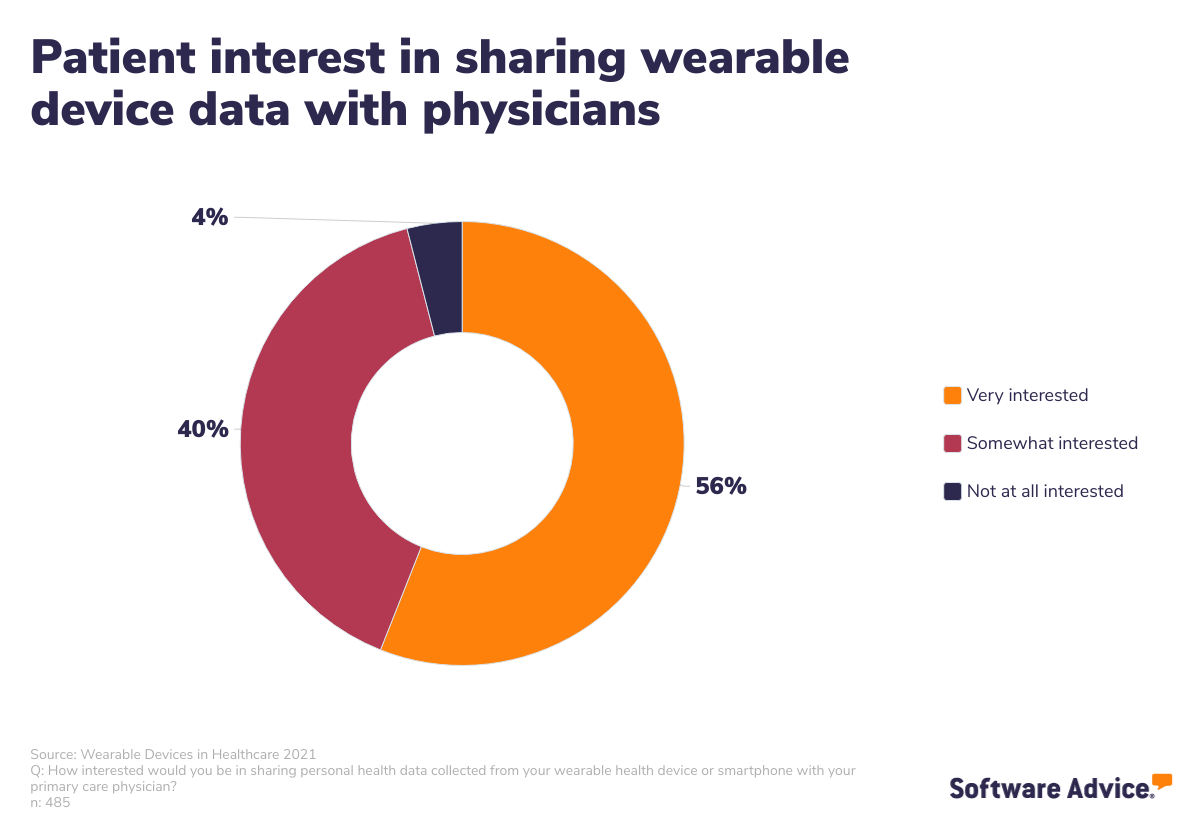
Not only will using your patient’s wearable device data help you get a better understanding of their overall health, but it makes you more marketable to a huge chunk of consumers who are already using these products on a regular basis.
Physical therapists and sports medicine specialists might be interested in ongoing heart rate and weight data. Additionally, OB-GYN doctors might find the menstrual cycle and fertility tracking features on smart watches monitors helpful to help plan patients’ care plans.
Blood pressure cuffs help patients with high blood pressure monitor their condition
Much like pulse oximeters and blood glucose monitors, the traditional way to track this data was manual. Patients would take their blood pressure, record it, then bring it in with them during their next scheduled meeting.
An at-home smart blood pressure cuff is similar to the one everyone has used at the doctor’s office except it’s done automatically and sends the data to a provider. Blood pressure cuffs are an easy way for patients to monitor and manage health conditions such as hypertension, diabetes, and kidney dysfunction at home. Thanks to the smart versions of these devices, it’s never been easier to get a holistic look into a patient’s condition.
Day-to-day monitoring of blood pressure benefits patients with ongoing high blood pressure because it provides a continuous look at the status of the heart, as opposed to a one-time view during a patient’s visit.
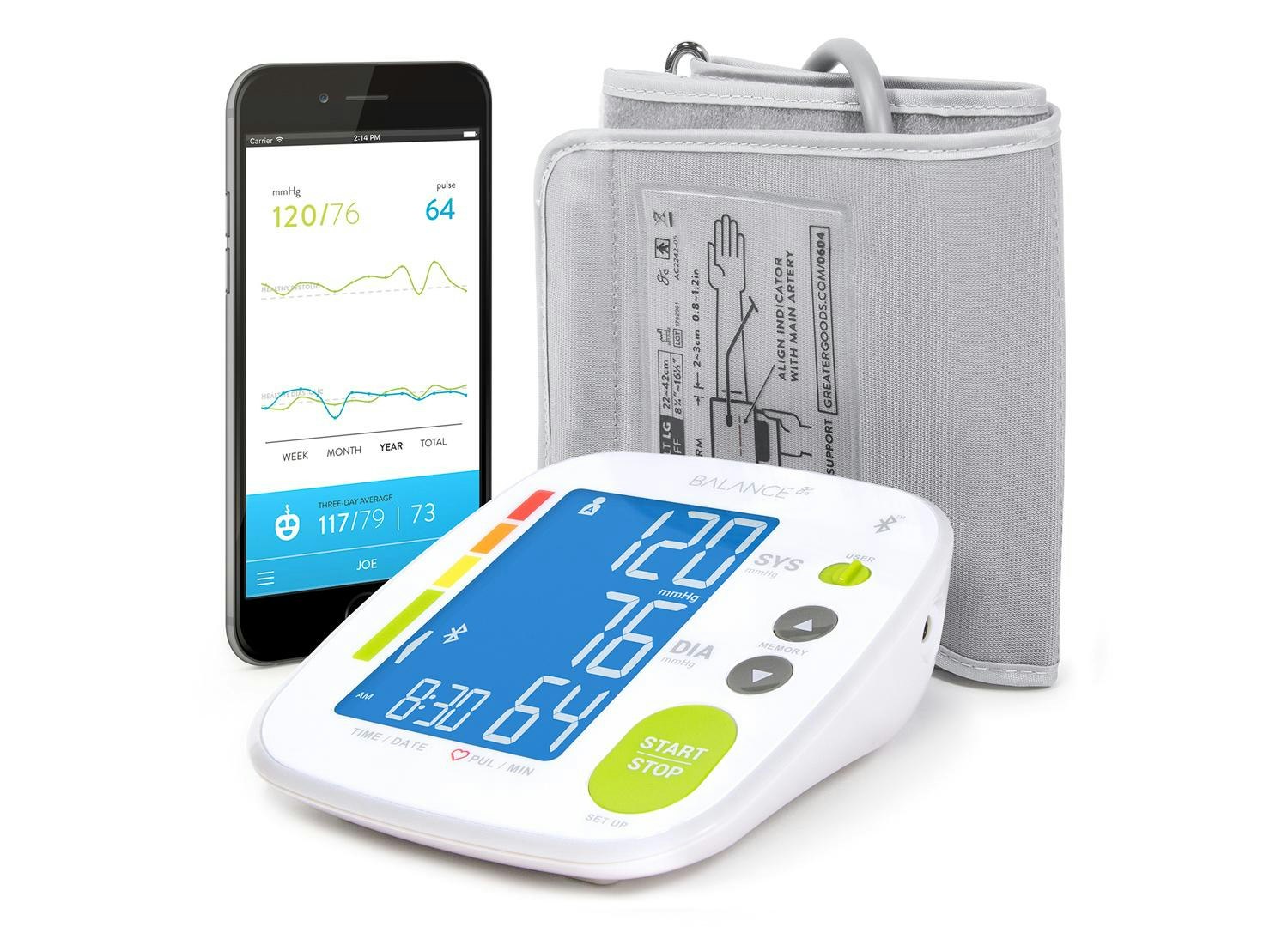
Greater Good’s bluetooth blood pressure monitor (Source)
A consistent look at blood pressure across multiple days and locations can also help you and your patient get a better idea about what situations might elevate blood pressure. Is their blood pressure higher at the office? Your clinic? Their home? By taking readings consistently, you and your patient can work together to form a more complete healthcare plan.
Cardiologists, care managers, and general healthcare providers who have a large number of patients with heart conditions should consider these types of remote patient monitoring devices.
Remote patient monitoring is just the start of the future of healthcare
With the increased want and need for telehealth, remote patient monitoring is becoming less of a nice-to-have and more or a must-have. Many of these remote monitoring devices have been around for decades, but with the advent of cloud computing and smart devices, it’s a no-brainer to take what your patients are already doing/using and make it more useful for everyone involved to improve health outcomes.
If you’re looking for more information about remote patient monitoring and how your practice can implement a remote patient monitoring program, we’ve got you covered:
3 Benefits of Remote Patient Monitoring in Healthcare You Need to Know
4 Remote Patient Monitoring Reimbursement Tips for Your Practice
Using remote patient monitoring as a part of your telehealth and virtual care platform can only be a net benefit for patients and practitioners, so your healthcare facility should consider it if you haven’t before.
If you’re thinking about starting a remote patient monitoring program, you might want to check out the video below for some quick tips about what makes a successful remote patient monitoring program.
For more information about telehealth and virtual care, check out What Is Virtual Care? A Guide for Your Medical Practice
If you want more information about what your patients think about wearables and remote patient monitoring, you can read the full report here: What You Don’t Know About Medical Wearable Devices and Remote Patient Monitoring—But Should
Finally, if you want more information about the benefits of telehealth, check out The Benefits of Telemedicine for Doctors and Patients
Methodology
Software Advice conducted this survey in August 2021 among 485 respondents to learn more about patient preferences and expectations for personal wearable device data and how it should be used by their healthcare providers. Respondents were screened for their location (United States) and how they kept track of their personal health history.
Note: The applications selected in this article are examples to show a feature in context and are not intended as endorsements or recommendations by Software Advice. They have been obtained from sources believed to be reliable at the time of publication.